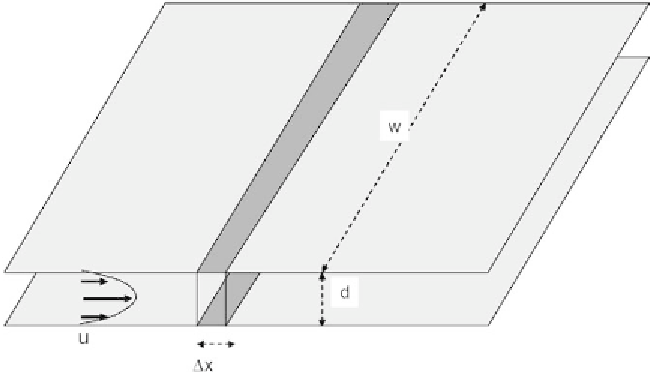Biomedical Engineering Reference
In-Depth Information
2.2.16 Microflows in Flat Channels: Helle-Shaw Flows
Flat channels—channels whose aspect ratio
d
/
w
is very small—are common in
biotechnology. There are used to force biologic targets to come to contact to the
wall, and to bind to immobilized ligands on the solid surface. A 3D approach to
such problems is not practical. In order to describe the vertical velocity profile,
very small meshes are required, and a large horizontal domain cannot be covered
with such small meshes. Clearly, the situation is close to 2D, but the friction on
the two walls cannot be disregarded, it is even the dominant friction force. In such
a case, the 2D Navier-Stokes equations need to be modified. For a steady state
low
2
2
µ
æ
ö
� �
∂
P
∂
u
∂
u
12
µ
�
(
(2.99)
ρ
u
.
Ñ = -
u
+
+
-
u
ç
÷
ç
÷
2
2
2
∂
x
∂
x
∂
y
d
è
ø
The additional force in the right-hand side of (2.99) is the friction on the upper
and bottom solid surfaces. Indeed, integrating this term on a
w d
D
x
parallelepiped
domain leads to
w x
+D
x d
/ 2
d
/ 2
1
12
µ
12
µ
D
x
12
µ
D
x
ò
ò
ò
ò
(2.100)
u dx dy dz
=
u dy
=
U
2
2
2
w d
d
d
d
d
0
x
-
d
/ 2
-
d
/ 2
which is the friction force on two parallel plates on a length D
x
(Figure 2.59).
Using (2.99) in a 2D formulation produces identical flow rates and pressures
than would a 3D calculation. Note that the maximum velocities are not identi-
cal because the 2D calculation averages the velocity in the vertical
z
-direction.
Hence, the maximum 2D velocity is only two-thirds of that obtained by the 3D
calculation.
Figure 2.59
Helle-Shawlowinlatmicrochannels.




